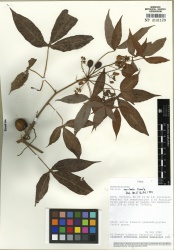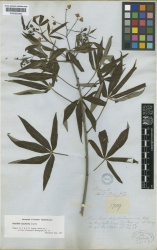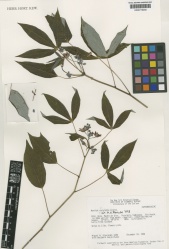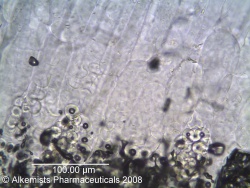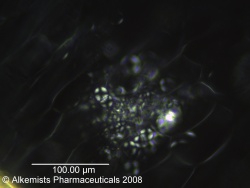Manihot esculenta (root)
(→add base structure) |
(add Kew voucher specimen reference) |
||
| (9 intermediate revisions by 3 users not shown) | |||
| Line 1: | Line 1: | ||
| − | = | + | {{DISPLAYTITLE:''Manihot esculenta'' (root) }} {{askbox|herb=''Manihot esculenta''}} |
| − | =Macroscopic | + | =Nomenclature= |
| − | =Microscopic | + | |
| − | = | + | {{nomenclature | binomial=Manihot esculenta |
| − | = | + | |authority=Crantz |
| − | + | |family=Euphorbiaceae | |
| + | |scn=cassava | ||
| + | |syn=''Janipha manihot'' (L.) Kunth; ''Jatropha manihot'' L. | ||
| + | |ayurvedic= | ||
| + | |pinyin= | ||
| + | |aka=bitter cassava; Brazilian arrowroot; manioc | ||
| + | |notes=The starch obtained from the roots of M. esculenta is commonly known as tapioca. }} | ||
| + | |||
| + | =Botanical Voucher Specimen= | ||
| + | |||
| + | {{Media3 |cat=Voucher | ||
| + | |||
| + | | source=MOBOT, Tropicos.org | ||
| + | | mainimage=Manihot_esculenta_Tropicos_100000722_(S).jpg | ||
| + | | companyimage=TropicosLogo.gif | ||
| + | | companyURL=http://www.tropicos.org/Image/100000722 | ||
| + | | reference=Tropicos.org. Missouri Botanical Garden. 26 Mar 2014 <http://www.tropicos.org/Image/100000722> | ||
| + | |||
| + | | companyimage2=Kewlogo.gif | ||
| + | | companyURL2=http://specimens.kew.org/herbarium/K000600386 | ||
| + | | image2=Manihot esculenta Kew barcode=K000600386 225709.jpg | ||
| + | | source2=Royal Botanic Gardens, Kew. | ||
| + | |||
| + | | companyimage3=Kewlogo.gif | ||
| + | | companyURL3=http://specimens.kew.org/herbarium/K000716450 | ||
| + | | image3=Manihot esculenta Kew barcode=K000716450 553207.jpg | ||
| + | | source3=Royal Botanic Gardens, Kew. | ||
| + | |||
| + | | }} | ||
| + | |||
| + | =Organoleptic Characteristics= | ||
| + | |||
| + | =Macroscopic Characteristics= | ||
| + | {| border=1 | ||
| + | | | ||
| + | {{Macroscopy | source=United States Dispensatory (1918) | ||
| + | | description=Tapioca is in irregular, hard, white, rough grains, possessing little taste, partially soluble in cold water, and affording a fine blue color when iodine is added to its filtered solution. The partial solubility in cold water is owing to the rupture of the starch granules by heat. }} | ||
| + | |} | ||
| + | |||
| + | =Microscopic Characteristics= | ||
| + | {| border=1 | ||
| + | | | ||
| + | {{Macroscopy | source=United States Dispensatory (1918) | ||
| + | | description=Examined under the microscope, the granules appear somewhat plano-convex or bell-shaped and more or less compound. The individual grains vary from 0.006 to 0.030 mm. in diameter and have a distinct central circular or radiating cleft. They polarize light strongly, showing a distinct cross. }} | ||
| + | |||
| + | {{Media2 |cat=Microscopy | source=Elan M. Sudberg, Alkemist Laboratories | ||
| + | | companyimage= AP-LOGO-Laboratories Crop - Copy.jpg | ||
| + | | companyURL=http://www.alkemist.com | ||
| + | | mainimage=Manihot_esculenta_-_Alkemist_Laboratories.jpg | ||
| + | | caption1=Starch granules of various sizes from 5-30 µm in diameter rounded and sub spherical observed with an irregularly stellate cleft at 400x with Acidified Chloral Hydrate Glycerol Solution. | ||
| + | | source2=Elan M. Sudberg, Alkemist Laboratories | ||
| + | | companyimage2= AP-LOGO-Laboratories Crop - Copy.jpg | ||
| + | | companyURL2=http://www.alkemist.com | ||
| + | | image2=Manihot_esculenta-1_-_Alkemist_Laboratories.jpg | ||
| + | | caption2=Starch granules of various sizes from 5-30 µm in diameter rounded and sub spherical seen under polarized light showing a linear hilum at 400x with Acidified Chloral Hydrate Glycerol Solution. | ||
| + | | reference=Powdered Vegetable Drugs, Jackson, B., 1968 | ||
| + | | }} | ||
| + | |} | ||
| + | =High Performance Thin Layer Chromatographic Identification= | ||
| + | |||
| + | =Supplementary Information= | ||
| + | =Sources= | ||
| + | <references /> | ||
Latest revision as of 15:02, 26 May 2015
Contents |
Nomenclature
Manihot esculenta Crantz Euphorbiaceae
Syn. Janipha manihot (L.) Kunth; Jatropha manihot L.
Standardized common name (English): cassava
Botanical Voucher Specimen
 |
 |
|
|
|
|
|
Organoleptic Characteristics
Macroscopic Characteristics
|
Microscopic Characteristics
|
High Performance Thin Layer Chromatographic Identification
Supplementary Information
Sources
- ↑ MOBOT, Tropicos.org http://www.tropicos.org/Image/100000722
- ↑ Royal Botanic Gardens, Kew. http://specimens.kew.org/herbarium/K000600386
- ↑ Royal Botanic Gardens, Kew. http://specimens.kew.org/herbarium/K000716450
- ↑ United States Dispensatory (1918)
- ↑ United States Dispensatory (1918)
- ↑ Elan M. Sudberg, Alkemist Laboratories http://www.alkemist.com
- ↑ Elan M. Sudberg, Alkemist Laboratories http://www.alkemist.com
